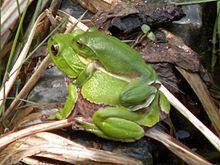Kingdom Animalia Order Anura Genus Rhacophorus Higher classification Rhacophorus | Phylum Chordata Family Rhacophoridae Scientific name Rhacophorus schlegelii Rank Species | |
 | ||
Similar Frog, Rhacophorus arboreus, Japanese tree frog, Rhacophoridae, Amphibians | ||
Breathing of amphibia rhacophorus schlegelii ns
Rhacophorus schlegelii (common names: Japanese gliding frog, Schlegel's green tree frog, Schlegel's flying frog, Schlegel's tree frog) is a species of frog in the family Rhacophoridae. It is endemic to Japan and found in Honshu, Shikoku, Kyushu as well as the Ryukyu Islands. It is named after Hermann Schlegel, a 19th century German zoologist.
Contents
- Breathing of amphibia rhacophorus schlegelii ns
- Breathing of amphibia buccal ventilation of rhacophorus schlegelii ns
- Description
- Reproduction
- Habitat and conservation
- References
Breathing of amphibia buccal ventilation of rhacophorus schlegelii ns
Description
Males measure 32–43 mm (1.3–1.7 in) and females 43–53 mm (1.7–2.1 in) in snout–vent length. The males have yellowish white nuptial pads, darkly colored throat, and a pair of slit-like vocal openings. The webbing of the fingers and toes is not well developed; the finger tips have truncated discs with circummarginal grooves. The dorsal skin is almost completely smooth. The supra-tympanic fold is prominent, but there is no dorsolateral fold.
Reproduction
Rhacophorus schlegelii breed in underground foam nests:
In Japan there is also a nest-making frog (Rhacoporus Schlegeli) which is said to lay its eggs sometimes amongst leaves on bushes or trees. However, its usual habit is to make a nest in the ground as indicated in Fig. 3. Awakening from their winter sleep, the frogs crawl along the edges of rice fields and swamps and dig out holes above the water level. The female carries the much smaller male, and both become buried in a hole 6–9 cm. wide and 10–15 cm. above the surface of the water. This nest cavity is smoothed inside by the movements of the female and is then, in the night, supplied with a ball of white matter full of air-bubbles. This is tough and elastic and 6–7 cm. thick. This mass is to supply moisture and air for the young. It emerges from the cloaca along with the eggs, and is then kneaded thoroughly by remarkable movements of the feet of the female. Stretching out and closing the toes, she mixes the sticky mass with air and breaks the big bubbles up into smaller and smaller foam. Similar movements of the feet of the male drive the mass backward and leave the eggs more free for the fertilization that follows. When the eggs have been fertilized and provided with a protecting and aerating mass, the parents break out from the nest and take up their life amongst the trees. The foam mass meanwhile gradually becomes liquid, and flowing out through the hole the parents left on leaving the nest, carries the young into the outside water.
Habitat and conservation
It occurs in temperate wetlands and forests from hilly areas to lowland areas, especially in paddy fields, which are its main breeding place. It is not considered threatened by the International Union for Conservation of Nature (IUCN).
